-
 Bitcoin
Bitcoin $106,782.3966
-0.72% -
 Ethereum
Ethereum $2,406.7764
-1.16% -
 Tether USDt
Tether USDt $1.0005
0.02% -
 XRP
XRP $2.0918
-1.53% -
 BNB
BNB $644.5785
-0.17% -
 Solana
Solana $141.0925
-0.69% -
 USDC
USDC $1.0000
0.02% -
 TRON
TRON $0.2721
0.18% -
 Dogecoin
Dogecoin $0.1585
-1.26% -
 Cardano
Cardano $0.5497
-1.14% -
 Hyperliquid
Hyperliquid $35.8493
-1.58% -
 Bitcoin Cash
Bitcoin Cash $502.3089
2.20% -
 Sui
Sui $2.7092
3.87% -
 Chainlink
Chainlink $12.8551
-1.85% -
 UNUS SED LEO
UNUS SED LEO $9.0548
0.53% -
 Stellar
Stellar $0.2344
-0.85% -
 Avalanche
Avalanche $17.2676
-0.23% -
 Toncoin
Toncoin $2.8282
0.56% -
 Shiba Inu
Shiba Inu $0.0...01113
-1.14% -
 Litecoin
Litecoin $83.9593
-0.93% -
 Hedera
Hedera $0.1447
0.82% -
 Monero
Monero $306.9022
-2.07% -
 Bitget Token
Bitget Token $4.6358
3.42% -
 Dai
Dai $0.9999
0.01% -
 Ethena USDe
Ethena USDe $1.0001
0.02% -
 Polkadot
Polkadot $3.3211
0.06% -
 Uniswap
Uniswap $6.8775
0.75% -
 Pi
Pi $0.5664
-0.27% -
 Aave
Aave $256.0055
1.28% -
 Pepe
Pepe $0.0...09013
-3.24%
Do three consecutive cross stars on the daily K-line indicate an imminent change?
Three consecutive cross stars on a crypto chart signal market indecision, often hinting at potential trend reversals or consolidation phases.
Jun 27, 2025 at 10:49 pm
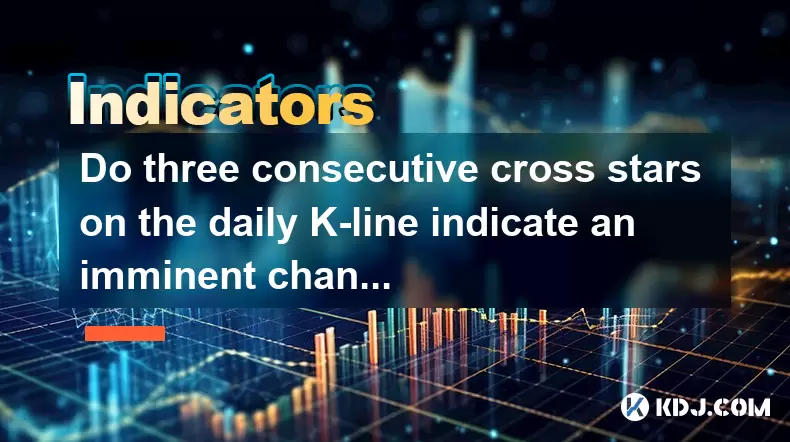
Understanding the Cross Star Pattern in Cryptocurrency Trading
In cryptocurrency trading, technical analysis plays a crucial role in predicting price movements. One of the commonly observed candlestick patterns is the cross star, which often signals potential market reversals or consolidation phases. When three consecutive cross stars appear on the daily K-line chart, traders may interpret this as a sign of significant shifts in market sentiment.
A cross star typically forms when the opening and closing prices are nearly equal, with long upper and lower shadows. This pattern suggests indecision among traders and often appears at critical support or resistance levels. In the volatile world of cryptocurrencies, such patterns can offer valuable insights into potential trend changes.
What Does a Single Cross Star Indicate?
Before analyzing the impact of three consecutive cross stars, it's essential to understand what a single cross star implies:
- A cross star at a high price level may indicate weakening bullish momentum.
- Conversely, a cross star at a low price level could suggest that bears are losing control.
- The length of the shadows determines the strength of the signal — longer shadows imply stronger rejection of current prices.
When a single cross star appears, experienced traders often wait for confirmation from subsequent candles before making decisions. This cautious approach helps avoid false signals, especially in markets prone to rapid fluctuations like crypto.
Interpreting Three Consecutive Cross Stars
Seeing three cross stars in a row on the daily chart is relatively rare but highly significant. This pattern indicates prolonged uncertainty and hesitation in the market:
- Each successive cross star reinforces the idea that neither bulls nor bears are gaining control.
- If this pattern occurs after a strong uptrend or downtrend, it may suggest an impending reversal.
- Volume during these sessions can provide additional clues — declining volume suggests lack of conviction, while rising volume might point to an imminent breakout.
Traders should closely monitor price action following this sequence. A decisive break above or below the range formed by these candles often confirms the direction of the next move.
How to Analyze Volume and Market Context
Volume is a key factor in validating any candlestick pattern, including three consecutive cross stars. Here’s how to incorporate volume analysis:
- Look for declining volume during the formation of cross stars — this usually signals weakening momentum.
- If volume spikes after the third cross star, it may indicate a strong move is about to begin.
- Compare the current price level with major support/resistance zones — cross stars near these levels are more meaningful.
Additionally, consider the broader market context. For example, if Bitcoin is forming cross stars while altcoins show strong momentum, the signal might be less reliable. Always cross-reference with other assets and macro indicators.
Practical Steps to Trade Based on This Pattern
If you observe three consecutive cross stars on the daily chart and wish to trade based on this setup, follow these steps carefully:
- Identify the trend leading up to the pattern — is it an uptrend, downtrend, or sideways movement?
- Examine the length and positioning of shadows — are they progressively getting longer or shorter?
- Wait for a breakout or breakdown confirmation before entering a position.
- Set stop-loss orders just beyond the highest or lowest shadow of the pattern to manage risk.
- Use moving averages or RSI to confirm overbought or oversold conditions.
Avoid jumping into trades immediately after the third cross star. Patience is vital in crypto trading, where false signals are common due to high volatility and frequent manipulation.
Common Pitfalls to Avoid
Many novice traders make mistakes when interpreting technical patterns like the cross star. Some common errors include:
- Acting too quickly without waiting for confirmation candles.
- Ignoring the importance of volume and market context.
- Failing to set proper stop-loss levels, leading to unnecessary losses.
- Overlooking the influence of news events or macroeconomic factors.
Remember, no candlestick pattern guarantees success. Treat each signal as part of a broader analytical framework rather than an isolated event.
Frequently Asked Questions
Q: Can three cross stars appear in intraday charts and still be meaningful?
Yes, although the significance of the pattern increases on higher timeframes like the daily chart. Intraday patterns require additional confirmation and are generally less reliable.
Q: What if the three cross stars have different shadow lengths?
Variations in shadow length are normal. Focus on the overall message — continued indecision. Longer shadows still carry more weight than short ones.
Q: How long should I wait for confirmation after the third cross star?
Typically, one or two candles following the pattern should provide enough clarity. If no clear direction emerges within three days, the signal weakens.
Q: Is this pattern equally valid across all cryptocurrencies?
The pattern works best on major, liquid assets like Bitcoin or Ethereum. On lesser-known altcoins, erratic price behavior may reduce its reliability.
Disclaimer:info@kdj.com
The information provided is not trading advice. kdj.com does not assume any responsibility for any investments made based on the information provided in this article. Cryptocurrencies are highly volatile and it is highly recommended that you invest with caution after thorough research!
If you believe that the content used on this website infringes your copyright, please contact us immediately (info@kdj.com) and we will delete it promptly.
- Bitcoin, Stablecoins, and Treasuries: A New Era of Digital Finance
- 2025-06-28 04:50:12
- Sei Price Surges with Double-Digit Gains: What's the Key Level?
- 2025-06-28 05:30:12
- GoMining: Gamified NFTs and the Future of Bitcoin Mining
- 2025-06-28 04:30:12
- Shiba Inu Price Forecast: Will the SHIB Surge Continue?
- 2025-06-28 05:30:12
- Prediction Markets, USDC Flows, and Stablecoin Utility: A New Era?
- 2025-06-28 05:30:12
- Hasbulla, Meme Coins, and Rug Pulls: A New York Minute on Crypto Chaos
- 2025-06-28 05:35:13
Related knowledge
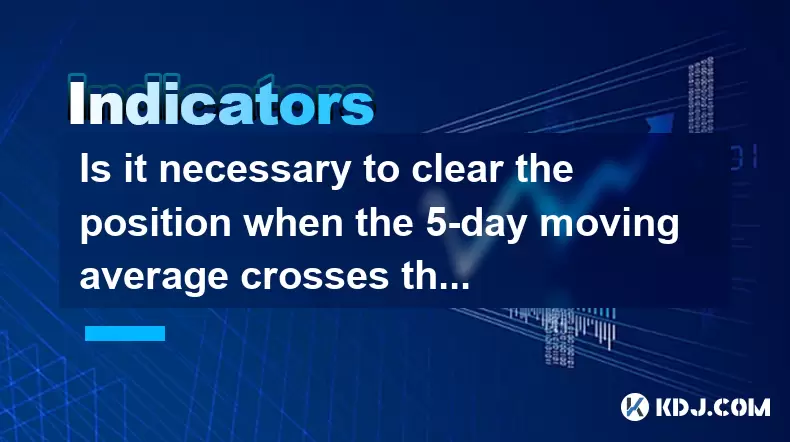
Is it necessary to clear the position when the 5-day moving average crosses the 10-day moving average?
Jun 27,2025 at 07:21pm
Understanding the 5-Day and 10-Day Moving AveragesIn the realm of technical analysis within the cryptocurrency market, moving averages play a crucial role in identifying trends and potential reversal points. The 5-day moving average (MA) and 10-day moving average are two of the most commonly used short-term indicators by traders. These tools smooth out ...
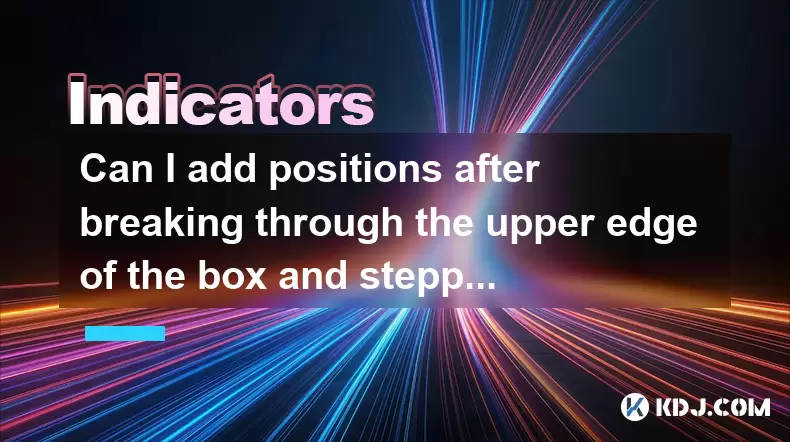
Can I add positions after breaking through the upper edge of the box and stepping back without breaking?
Jun 27,2025 at 09:56pm
Understanding the Box Breakout StrategyIn cryptocurrency trading, box breakout strategies are commonly used by technical analysts to identify potential price movements. A box, or a trading range, refers to a period where the price of an asset moves within two horizontal levels — the support (lower boundary) and resistance (upper boundary). When the pric...
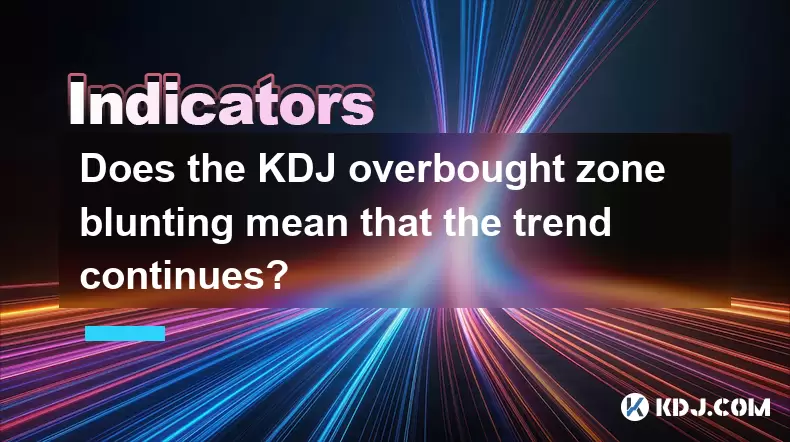
Does the KDJ overbought zone blunting mean that the trend continues?
Jun 27,2025 at 03:35pm
Understanding the KDJ Indicator in Cryptocurrency TradingThe KDJ indicator, also known as the stochastic oscillator, is a popular technical analysis tool used by traders to identify overbought or oversold conditions in asset prices. In the cryptocurrency market, where volatility is high and trends can change rapidly, understanding how to interpret the K...
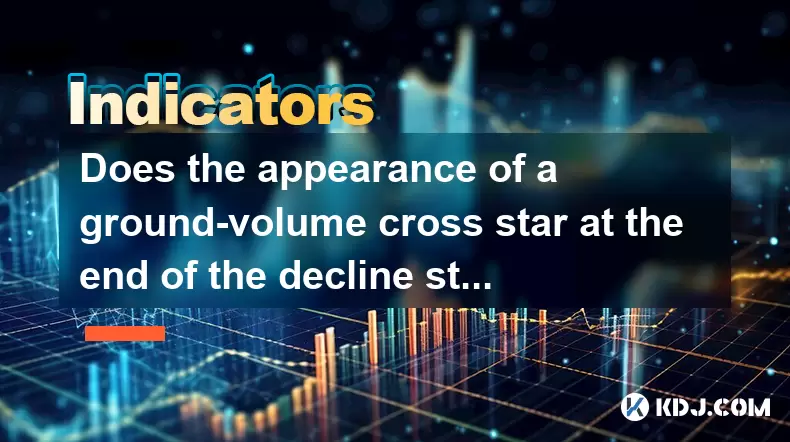
Does the appearance of a ground-volume cross star at the end of the decline stop the decline?
Jun 27,2025 at 10:35pm
Understanding the Ground-Volume Cross Star PatternIn technical analysis, candlestick patterns play a crucial role in identifying potential market reversals. One such pattern is the ground-volume cross star. This pattern typically appears at the bottom of a downtrend and is characterized by a small-bodied candle with long upper and lower shadows, accompa...
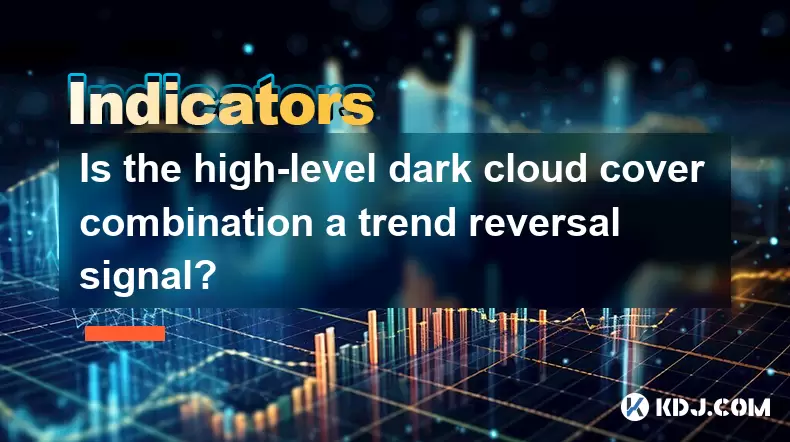
Is the high-level dark cloud cover combination a trend reversal signal?
Jun 28,2025 at 05:28am
Understanding the High-Level Dark Cloud Cover PatternThe high-level dark cloud cover is a well-known candlestick pattern that often appears at the end of an uptrend. This pattern typically signals a potential reversal from bullish to bearish sentiment in the market. In the context of cryptocurrency trading, where price movements can be highly volatile, ...
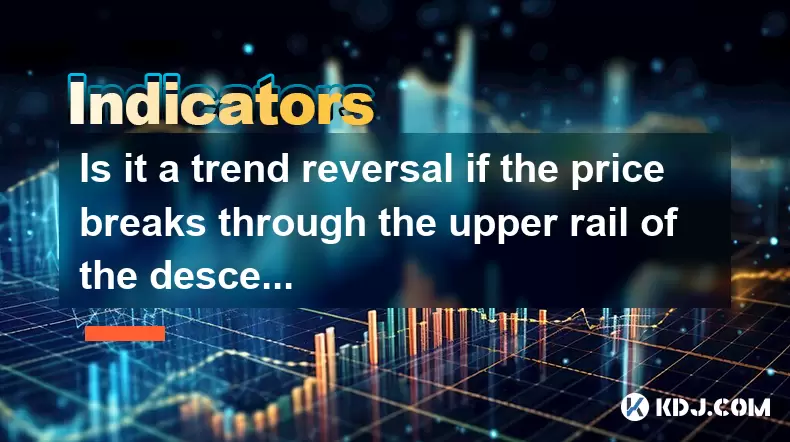
Is it a trend reversal if the price breaks through the upper rail of the descending channel and then steps back without breaking?
Jun 27,2025 at 05:35pm
Understanding the Descending Channel PatternA descending channel is a technical analysis pattern formed by two parallel downward-sloping trendlines, one acting as resistance and the other as support. This pattern typically indicates a continuation of a downtrend, where price action oscillates between these two boundaries. Traders often look for breakout...

Is it necessary to clear the position when the 5-day moving average crosses the 10-day moving average?
Jun 27,2025 at 07:21pm
Understanding the 5-Day and 10-Day Moving AveragesIn the realm of technical analysis within the cryptocurrency market, moving averages play a crucial role in identifying trends and potential reversal points. The 5-day moving average (MA) and 10-day moving average are two of the most commonly used short-term indicators by traders. These tools smooth out ...

Can I add positions after breaking through the upper edge of the box and stepping back without breaking?
Jun 27,2025 at 09:56pm
Understanding the Box Breakout StrategyIn cryptocurrency trading, box breakout strategies are commonly used by technical analysts to identify potential price movements. A box, or a trading range, refers to a period where the price of an asset moves within two horizontal levels — the support (lower boundary) and resistance (upper boundary). When the pric...

Does the KDJ overbought zone blunting mean that the trend continues?
Jun 27,2025 at 03:35pm
Understanding the KDJ Indicator in Cryptocurrency TradingThe KDJ indicator, also known as the stochastic oscillator, is a popular technical analysis tool used by traders to identify overbought or oversold conditions in asset prices. In the cryptocurrency market, where volatility is high and trends can change rapidly, understanding how to interpret the K...

Does the appearance of a ground-volume cross star at the end of the decline stop the decline?
Jun 27,2025 at 10:35pm
Understanding the Ground-Volume Cross Star PatternIn technical analysis, candlestick patterns play a crucial role in identifying potential market reversals. One such pattern is the ground-volume cross star. This pattern typically appears at the bottom of a downtrend and is characterized by a small-bodied candle with long upper and lower shadows, accompa...

Is the high-level dark cloud cover combination a trend reversal signal?
Jun 28,2025 at 05:28am
Understanding the High-Level Dark Cloud Cover PatternThe high-level dark cloud cover is a well-known candlestick pattern that often appears at the end of an uptrend. This pattern typically signals a potential reversal from bullish to bearish sentiment in the market. In the context of cryptocurrency trading, where price movements can be highly volatile, ...

Is it a trend reversal if the price breaks through the upper rail of the descending channel and then steps back without breaking?
Jun 27,2025 at 05:35pm
Understanding the Descending Channel PatternA descending channel is a technical analysis pattern formed by two parallel downward-sloping trendlines, one acting as resistance and the other as support. This pattern typically indicates a continuation of a downtrend, where price action oscillates between these two boundaries. Traders often look for breakout...
See all articles























































































